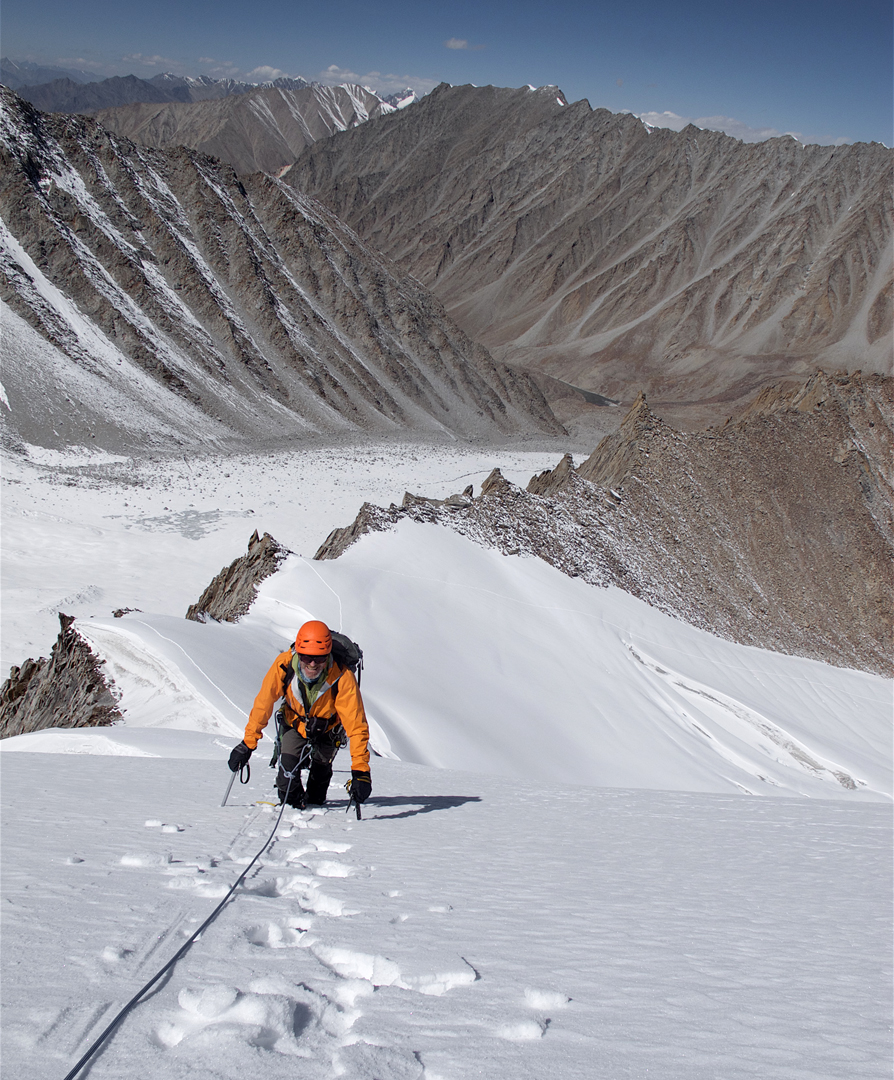Sumur Glacier, Various Ascents
India, East Karakoram

UNTIL RECENTLY, there has been little exploration by foreign mountaineers of the more remote areas of the East Karakoram. The availability of permits for the region is still not a foregone conclusion. In 2016 we successfully obtained permission to visit the lower Rassa Glacier (AAJ 2017), but with so much more to be explored, we decided to return in 2017 in order to attempt some of the unclimbed mountains approachable from the more northerly Sumur Glacier. Our hope was that we could access the upper Rassa Glacier via the East Rassa Col, a high pass crossed in 2014 from south to north by Divyesh Muni’s expedition (AAJ 2015). Failing this, we would attempt virgin peaks bordering the Sumur Glacier itself.
Once again we suffered the anguish of not knowing whether our proposal would be allowed. Permission was received literally weeks prior to our departure, leaving just enough time for visa applications to be processed. Five Alpine Club members—Drew Cook, Jamie Goodhart (who unfortunately left the expedition early on hearing of a family bereavement), Rafal Malczyk, Howard Pollitt, and I as leader—left the U.K. for a five-week expedition lasting from August 31 to October 7.
We spent four days acclimatizing in Leh before crossing the Kardung La to the village of Sumur in the Nubra Valley, where we spent an additional two days arranging porters for the trek to base camp. On September 8 we transferred to the road head at Samstanling Gompa, prior to making what should have been an arduous two-day trek up the Sumur Lungpa to a base camp at 5,160m by the Sumur lakes. Problems with porterage meant that base camp was not fully functional until sometime later, but this did not prevent us from establishing an embryonic camp, from which we made exploratory forays onto the complex Sumur Glacier.
Subsequent exploration led to two high camps on the southerly arm of the glacier: Camp 3 at 5,500m and Camp 4 at 5,743m. On September 16 we made an attempt on Peak 5,991m, aborted due to unstable snow conditions. On the 18th, after post-holing badly up the easy-angled glacier from the higher camp, Cook, Malczyk, Pollitt, and I eventually reached the convergence of three ridges at the head of the glacier (6,068m, 34º39.613’N, 77º47.324’E). We initially had thought this to be a distinct mountain, but it was not, as such, so we named it, appropriately, Deception Point. Disappointingly, while it offered good views, we could see no realistic way to move onto the upper Rassa Glacier.
There was little more we could do from this glacial arm, so we refocused on the arm immediately north, where, on the 21st, we established Camp 5 at 5,680m. On the 25th, all four of us made the first ascent of the twin-headed peak at the head of the glacier via its south face. We first climbed the rock-capped south summit (6,071m, 34º40.970’N, 77º47.426’E, PD), then traversed to the slightly higher and snow-capped north summit (6,078m, 34º41.068’N, 77º47.543’E). We chose to call this peak Tsagtuk Kangri (Ladakhi for “Twin Snow Peak”). From the northern peak, we returned directly to Camp 5.
|
| Sumur Kangri (5,991m) and the route of first ascent up the west-northwest ridge, as seen from a camp at 5,500m on the southern arm of the Sumur Glacier. The northwest face of unclimbed Nya Kangri (6,480m) is behind. Photo by Derek Buckle |
Before returning to base camp, we made an exploratory foray to the foot of the East Rassa Col to establish the viability of using this north-facing slope as an access point to the upper Rassa Glacier. However, heavy bouts of snowfall had made all north-facing slopes extremely prone to avalanche, and the instability of the slope leading to the col was unequivocally established after making a snow pit. We therefore returned to Camp 3 for a second attempt on Peak 5,991m (34º38.184’N, 77º45.866’E).
On September 29, Cook, Malczyk, and I made the first ascent of this peak via the steep west-northwest ridge at AD. The corniced summit offered fantastic views of unclimbed Nya Kangri (6,480m) and beyond. On account of its dominant position, we chose to name this peak Sumur Kangri.
We are indebted to the Mount Everest Foundation, the Montane Alpine Club Climbing Fund, and the Austrian Alpine Club (U.K.) for financial support. We also thank Rimo Expeditions, as without them our task would have been immeasurably harder.
– Derek Buckle, Alpine Club, U.K.










